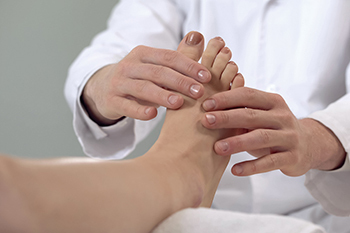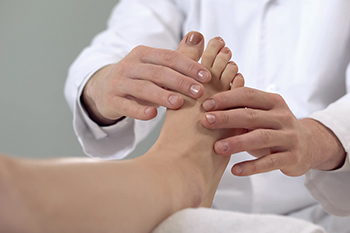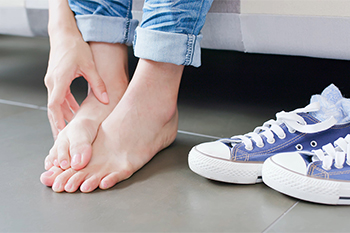September 2022

There is a foot condition known as Sever’s Disease that affects children and young teenagers. Frequently children who participate in sporting activities experience this condition and it can cause intense heel pain. The medical term for Sever’s disease is calcaneal apophysitis and this name is derived after James Warren Sever, who detected this condition back in 1912. Sever’s disease can occur as a result of extreme force being placed on the growth plate of the heel. The heel bone in children and young teenagers may grow at a faster pace than the surrounding tissues and tendons, which may lead to overstretching. This can cause the heel to have a reduced range of motion and added pressure is placed on the heel plate. Healing can start with temporarily stopping the activity that caused the pain and it may be beneficial to elevate the affected foot as often as possible. If your child has heel pain, please consult with a chiropodist who can effectively diagnose and treat the problem.
Sever’s disease typically affects young children and teenagers. If your child complains of foot pain, please consult with one of the chiropodists from The Footcare Centre. Our chiropodists will assess your condition and provide you with quality foot and ankle treatment.
What Is Sever’s Disease?
Sever’s disease, also known as calcaneal apophysitis, is an inflammation of the growth plate in the heel bone. It is typically caused by overuse due to repetitive activities such as running, jumping, and playing certain sports. This condition most frequently affects children between the ages of 8 and 14.
Symptoms
Symptoms of Sever’s disease include:
Pain in the back or bottom of the heel
Pain when the sides of the heel are squeezed
Limping or walking on tiptoes to avoid putting pressure on the heel
Difficulty running, jumping, or participating in usual activities
Fatigue
Diagnosis
Sever’s disease is diagnosed by taking a thorough medical history and performing a physical examination. Imaging studies, such as an X-ray, can help rule out other injuries like a fracture.
Treatment
Sever’s disease typically heals without any long-term complications. Treatment involves resting the affected foot by reducing typical activities, wearing orthotics to support the foot, immobilizing the affected foot, taking medications to reduce pain and inflammation, and stretching the foot.
If you have any questions, please feel free to contact our office located in . We offer the newest diagnostic and treatment technologies for all your foot care needs.

Patients who experience ankle pain often have difficulty in completing daily activities. There are various reasons why ankle pain can occur, including an injury, stepping off of a curb unexpectedly, or possibly from muscle weakness. There are noticeable symptoms that often accompany ankle pain. These consist of difficulty in putting weight on the affected foot, swollen calves, and pain that may gradually become worse. Ankle pain may be a result of an ankle sprain or a broken foot, and immediate medical attention is often sought for relief. Many patients use an elastic bandage that can help to stabilize the ankle until a chiropodist is contacted. It is beneficial to refrain from bearing any weight on the ankle, and crutches are often used for mobility. There may be specific stretches that can be performed, and this may depend on the reason for the ankle pain. If you have this type of pain, please consult with a chiropodist who can effectively determine the cause and offer correct treatment options.
Ankle pain is a common symptom of many lower limb problems. If you are experiencing ankle pain, please consult with one of the chiropodists from The Footcare Centre. Our chiropodists will assess your condition and provide you with quality foot and ankle treatment.
The ankle is composed of a number of muscles, bones, tendons, and ligaments. There are many conditions which may cause ankle pain.
Causes
Ankle strains or sprains
Achilles tendon injuries
Fractures
Bursitis
Arthritis
Gout
Tarsal tunnel syndrome
Symptoms
If you have ankle pain, you may also experience a variety of other symptoms depending on the underlying cause of the pain. Some of these symptoms may include ankle swelling, bruising, redness, numbness or tingling, instability, and difficulty walking.
Diagnosis
The underlying cause of ankle pain can be diagnosed by a chiropodist. Diagnoses are typically made based on your medical history, a physical examination of the affected ankle, and imaging studies such as X-rays.
Treatment
Treatment for your ankle pain will depend on its underlying cause. Often, the chiropodist will recommend that you rest the affected ankle. You might also need to ice, compress, and elevate the ankle, wear an orthotic device, or take medications to reduce pain and inflammation.
If you have any questions, please feel free to contact our office located in . We offer the newest diagnostic and treatment technologies for all your foot care needs.

Arthritis is an overall term that means joint inflammation. There are around 100 types of arthritis with the most common being osteoarthritis. Because the foot is made up of about 26 bones and 30 joints, arthritis of the foot and ankle is common. The joints most likely to become arthritic are in the ankle, midfoot/heel, and big toe. Symptoms include pain or tenderness, difficulty walking, swelling, and stiffness in the joint. Non-surgical treatment of foot and ankle arthritis includes losing weight, using a cane or walker, custom orthotics, anti-inflammatory medication, and steroid injections. If you believe you may have arthritis in the foot or ankle, it is a good idea to consult a chiropodist who will begin by asking for your medical history, and then ask questions about the source of the pain and what may have caused it. A test called a gait analysis may be conducted, and X-rays may be taken. A chiropodist will then have the information needed to determine the best course of treatment for you.
Osteoarthritis in the feet or ankles can be a painful and disabling condition that may interfere with your daily activities. If you have arthritis, please consult with one of the chiropodists from The Footcare Centre. Our chiropodists will assess your condition and provide you with quality foot and ankle treatment.
What Is Osteoarthritis?
Osteoarthritis is a condition in which the protective layer of cartilage in the joints breaks down over time. This loss of cartilage causes the bones to rub together during movement, leading to pain and inflammation. Osteoarthritis is associated with aging, and often affects the small joints of the feet and ankles.
Symptoms
Symptoms of osteoarthritis include:
Joint pain
Joint stiffness
Swelling in or around the joint
Restricted range of motion
Difficulty walking
Diagnosis
Osteoarthritis can be diagnosed through physical examination. You may also need to have an X-ray taken to assess the extent of the damage caused by arthritis.
Treatment
Treatment for osteoarthritis focuses on reducing symptoms and improving the function of the affected joints. Conservative treatments include oral pain medications, orthotic devices, bracing or immobilizing the affected foot or ankle, steroid injections into the affected joint to reduce inflammation, and physical therapy. In more severe cases, surgery may be necessary.
If you have any questions, please feel free to contact our office located in . We offer the newest diagnostic and treatment technologies for all your foot care needs

A variety of different fungi can cause a skin infection known as athlete’s foot. It can be quite uncomfortable and may have symptoms that consist of itching, red, and dry skin. The medical name for athlete’s foot is referred to as tinea pedis which lives in warm and moist environments. These can include public swimming pools, shower room floors, and locker rooms. It is suggested to wear appropriate shoes while in these types of areas as this may help to avoid getting athlete’s foot. Additionally, other effective prevention methods can consist of trimming the toenails correctly and avoiding wearing shoes or socks that are not made of breathable materials. The feet will feel better when they are kept dry and cool, and it is beneficial to air out any shoes that are worn approximately every other day. Athlete’s foot can be difficult to treat and may be recurring. If you are afflicted with this condition, it is advised that you schedule an appointment with a chiropodist who can prescribe the necessary medication.
Athlete’s foot can be uncomfortable and unsightly. To learn more about preventing and treating this condition, please consult with one of the chiropodists from The Footcare Centre. Our chiropodists will assess your condition and provide you with quality foot and ankle treatment.
What Is Athlete’s Foot?
Athlete’s foot refers to an infection of the skin on the feet that is caused by a fungus. This fungus is contagious and thrives in warm and moist environments. It is often spread in common areas such as public pools, locker rooms, and showers. It can also spread when sharing personal items, like shoes or towels, with an infected person.
Symptoms
The symptoms of athlete’s foot may include:
Itching, stinging, or burning of the skin on the feet
Cracking or peeling skin, especially between the toes and on the soles of the feet
Scaly, red rash on the foot
Blisters
Foul odor
Treatment
Treatment for athlete’s foot typically involves using over-the-counter topical antifungal medications on the feet. When over-the-counter options are ineffective, you may need to take prescription oral medications or topical antifungal drugs, or a combination of both.
Prevention
Preventing athlete’s foot places an emphasis on good foot hygiene practices.
You can prevent athlete’s foot by:
Washing and drying your feet thoroughly every day
Wearing shoes when walking in public areas
Not sharing personal items, like shoes or socks, with others
Wearing shoes and socks made out of breathable materials
If you have any questions, please feel free to contact our office located in . We offer the newest diagnostic and treatment technologies for all your foot care needs.
Blog Archives
- 2024
- 2023
- 2022
- 2021
- 2020


